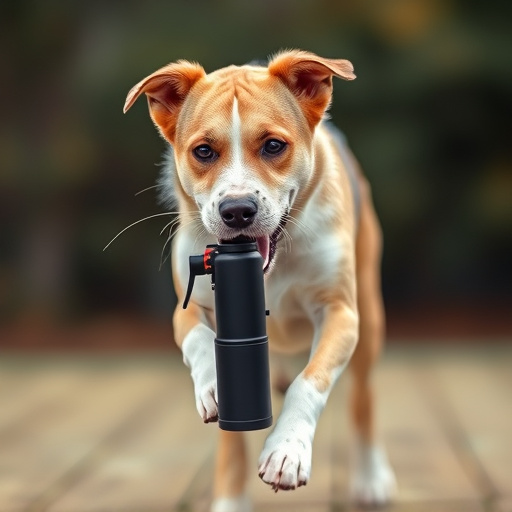Dog pepper spray, using capsaicin to temporarily disable aggressive dogs, is a crucial self-defense tool. Effective defense drills involve practice in controlled settings, learning proper application distance and technique, and understanding the spray's effects. Regular training sessions for both humans and their dogs can significantly enhance safety against dog attacks, utilizing positive reinforcement and diverse environmental drills to ensure effectiveness.
“Uncover the power of effective pepper spray dog defense drills. This comprehensive guide explores ‘Understanding Dog Spray: The Basics’ to ensure you’re informed about its safe and strategic use. We delve into the ‘Efficacy of Pepper Spray Against Dogs,’ providing insights into its performance as a deterrent. Additionally, learn practical ‘Implementation Tips’ and ‘Training Advice for Optimal Results’ to turn your pepper spray into a reliable defense mechanism against canine intruders.”
- Understanding Dog Spray: The Basics
- Efficacy of Pepper Spray Against Dogs
- Implementing Safe and Effective Defense Drills
- Training Tips for Optimal Results
Understanding Dog Spray: The Basics
Dog spray, also known as pepper spray for dogs, is a non-lethal deterrent designed to temporarily incapacitate and disrupt an attacking dog. It’s a safe and effective solution for dog defense drills, offering a quick response to potentially dangerous situations. This type of spray contains capsaicin, the same compound found in hot peppers, which irritates the dog’s eyes, nose, and throat, leading to temporary blindness, coughing, and discomfort.
When used properly, dog spray can be a powerful tool for personal safety. Effective pepper spray dog defense drills involve understanding how to apply the spray accurately and at close range, as well as knowing the right techniques to de-escalate the situation. Training in these drills ensures that individuals can respond swiftly and effectively when confronted by an aggressive dog, providing a safe escape or the time needed to call for help.
Efficacy of Pepper Spray Against Dogs
Pepper spray has long been recognized as an effective deterrent and self-defense mechanism against various threats, including dogs. When it comes to dog interactions, pepper spray can be a valuable tool for individuals seeking to protect themselves in unexpected encounters. The key ingredient, capsaicin, is naturally derived from chili peppers and provokes a burning sensation when introduced to the eyes and respiratory system of the target animal. This irritant disrupts normal vision and breathing, providing the user with a crucial moment to escape or de-escalate the situation.
For dog owners and individuals in areas with high dog populations, practicing defense drills with effective pepper spray can be life-saving. Training sessions should include scenarios that simulate sudden, aggressive dog encounters, teaching users how to accurately deploy the spray while maintaining their own safety. Regular practice ensures that when faced with such an event, the user’s reflexes are honed, making it a powerful and safe method of self-defense against dogs without causing them permanent harm.
Implementing Safe and Effective Defense Drills
Implementing safe and effective defense drills with pepper spray is a crucial step in equipping yourself to handle potential dog attacks. Start by familiarizing yourself with the spray’s functionality, including its range, potency, and activation mechanism. Practice target practice to ensure accurate deployment under stress. Engage in simulated encounters with a trusted partner or professional trainer to simulate various attack scenarios. This training should include learning the proper distance to maintain from an approaching dog, how to activate the spray effectively, and understanding the effects it will have on the animal.
During these drills, prioritize safety above all else. Wear protective gear such as gloves and goggles to minimize exposure to pepper spray. Choose a controlled environment, like an open field or training area, where you can conduct these exercises without endangering others or your property. Regularly review and update your defense strategies based on new techniques and recommendations from experts in dog behavior and safety. Remember, consistent practice with effective pepper spray dog defense drills is key to ensuring your readiness when facing a real-world threat.
Training Tips for Optimal Results
Training your dog to respond effectively to pepper spray can be a game-changer for their safety, especially in unexpected situations. Start by introducing the concept gradually; allow your dog to sniff and get used to the scent of the spray without any activation. This familiarization process helps reduce fear and makes them more receptive to training. Use positive reinforcement techniques; reward your dog with treats and praise when they display calm behavior or perform commands after exposure to the spray.
Implementing practical drills is crucial for optimal results. Practice in various environments, both indoors and outdoors, to ensure your dog can generalize their response. Incorporate distraction drills where you simulate unexpected events to test their ability to focus on commands. Regularly review and repeat these defense drills to reinforce learning. The consistency of training will make a significant difference in the effectiveness of pepper spray as a deterrent during potential threats.
Dog spray, or pepper spray, has proven to be an effective deterrent when used correctly. By understanding its basics, implementing safe defense drills, and incorporating training tips, individuals can ensure they are well-prepared to handle potential dog encounters. These effective pepper spray dog defense drills offer a powerful yet non-lethal means of self-protection, promoting safety in various scenarios without causing long-term harm.
